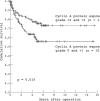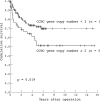Expression and gene amplification of primary (A, B1, D1, D3, and E) and secondary (C and H) cyclins in colon adenocarcinomas and correlation with patient outcome
- PMID: 15858123
- PMCID: PMC1770669
- DOI: 10.1136/jcp.2004.020347
Expression and gene amplification of primary (A, B1, D1, D3, and E) and secondary (C and H) cyclins in colon adenocarcinomas and correlation with patient outcome
Abstract
Background/aims: Deregulation of cell cycle control is a hallmark of cancer. The primary cyclins (A, B1, D1, D3, and E) are crucial for cell cycle progression. Secondary cyclins (C and H) have putative indirect effects on cell cycle progression and have not previously been evaluated in colon cancer. This study examined cyclin protein expression and gene amplification in colon adenocarcinoma and the correlation with patient outcome.
Methods: Immunohistochemistry and real time quantitative polymerase chain reaction were used to determine cyclin expression and gene amplification in 219 tumours. The results were compared with clinical variables and patient outcomes.
Results: Cyclin H was overexpressed in all tumours, cyclin C in 88%, cyclin B1 in 58%, cyclin A in 83%, cyclin D3 in 36%, cyclin E in 25%, and cyclin D1 in 11% of the tumours. Extra gene copies of cyclin A were seen in 6.2% of the tumours, cyclin B1 in 9%, cyclin C in 26.9%, cyclin D1 in 55%, cyclin D3 in 20.5%, cyclin E in 19.1%, and cyclin H in 5.1%. A significant correlation between protein overexpression and gene amplification was seen for cyclin C only. High expression of cyclin A was independently associated with improved survival. Amplification of cyclin C was independently associated with an unfavourable prognosis.
Conclusions: Amplification of the cyclin C gene was related to an unfavourable prognosis and high protein expression of cyclin A was associated with a better outcome in colon adenocarcinoma.
Figures



References
-
- Hanahan D, Weinberg RA. The hallmarks of cancer. Cell 2000;100:57–70. - PubMed
-
- Murray AW. Creative blocks: cell-cycle checkpoints and feedback controls. Nature 1992;359:599–604. - PubMed
-
- Morgan DO. Principles of CDK regulation. Nature 1995;374:131–4. - PubMed
-
- Sherr CJ, Roberts JM. Inhibitors of mammalian G1 cyclin-dependent kinases. Genes Dev 1995;9:1149–63. - PubMed
-
- Nasmyth K . Viewpoint: putting the cell cycle in order. Science 1996;274:1643–5. - PubMed
MeSH terms
Substances
LinkOut - more resources
Full Text Sources
Other Literature Sources
Research Materials
